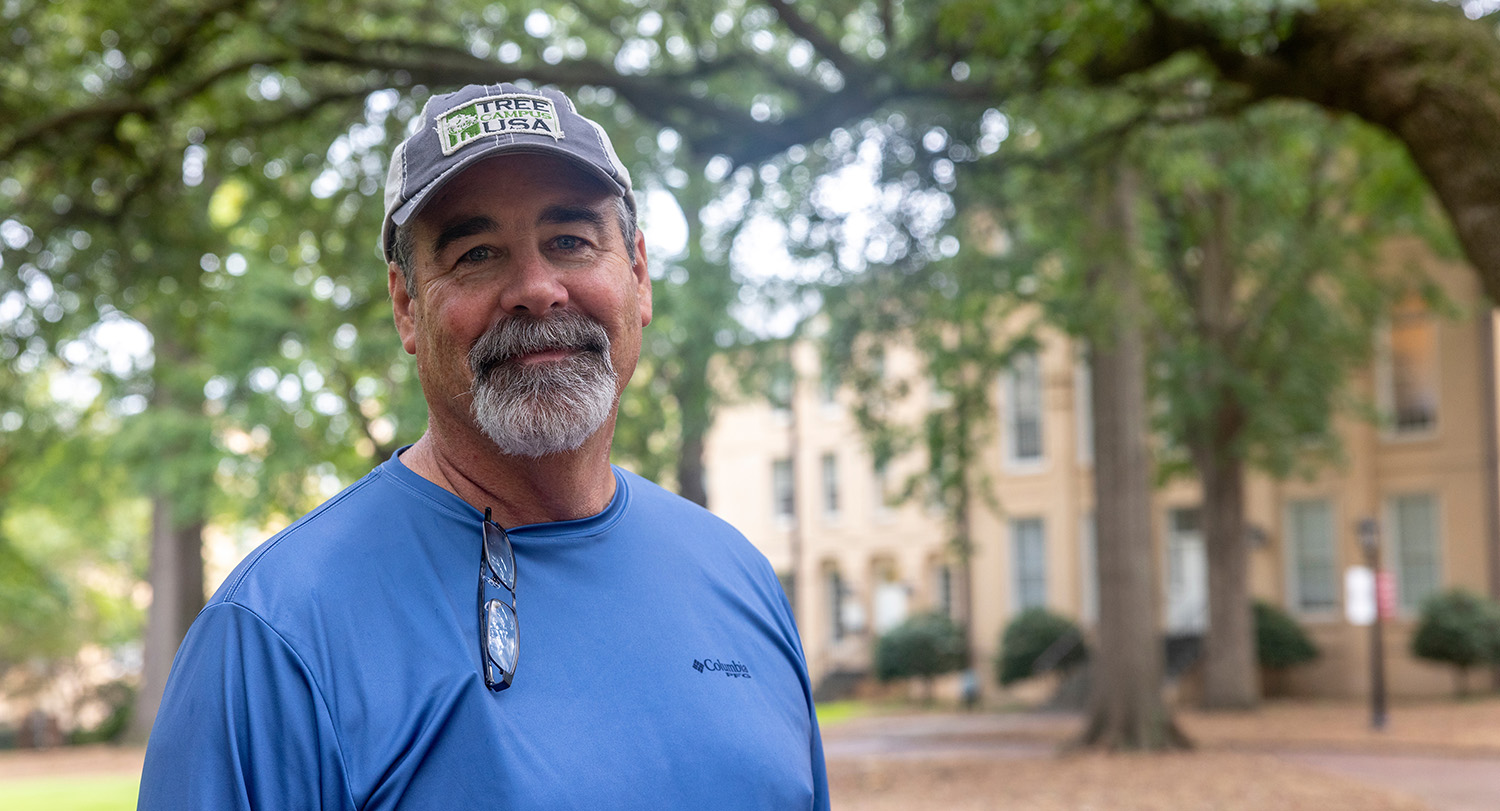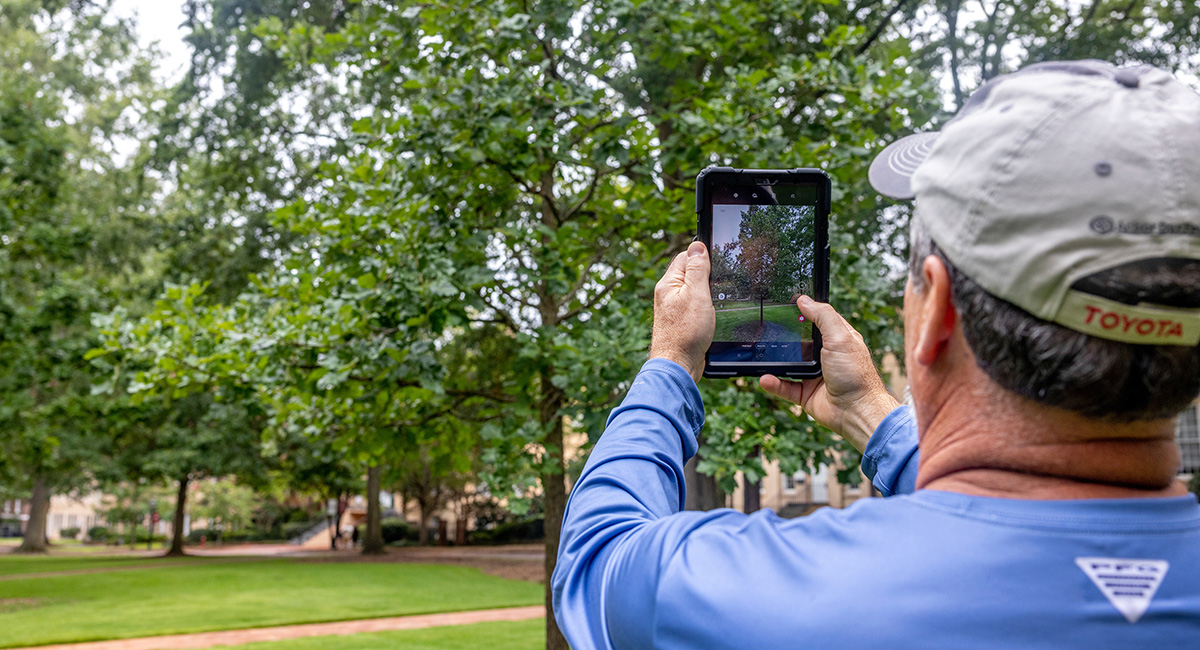
If you’ve ever set foot on the University of South Carolina campus, you know that its trees are central to its character. But you probably don’t know just how many trees there are, or how many different types.
That’s where Tom Knowles comes in. Recently retired from his role as assistant director of facilities services, Knowles came back to the university as a project arborist over the summer to conduct a full inventory of all campus trees. It’s part of the university’s ongoing commitment to sustainability and urban forest management, which has been consistently recognized by the Arbor Day Foundation with its Tree Campus Higher Education distinction.
“Facilities Services is committed to creating and maintaining both a beautiful and a functional campus environment. As part of our commitment to sustainability, it is also important that we are mindful of our environmental impact as we work to be good stewards of the campus buildings and grounds,” says Jason Lambert, the associate vice president of Facilities Management. “Each day, the men and women of Facilities Services work very hard to ensure that the first impression anyone receives of our campus–our grounds and beautiful urban forest–is an amazing one.”
We spoke to Knowles about the inventory project, the steps Facilities Services takes to preserve the campus forest, and some of his favorite spots on campus. Below is an edited transcript of our conversation.
Why do this inventory?
Each year, we report things like number of trees on campus or percent of canopy, how many trees we planted, how many we prune and more for our Tree Campus Higher Ed program that the Arbor Day Foundation runs. And as the facilities department develops their GIS management for the university, from sprinklers to utility lines and other infrastructure assets, this is another layer to help the planning department.
Remember eighth grade science class: Trees give off oxygen and they help keep places cooler.
We’re on the Horseshoe, which most people think of when they think of our urban forest area. Describe some of what we have here.
If you start walking around the Horseshoe, you'll see all the different sizes. You can tell the ones that have been here for maybe 80 to 100 years, some of these big ones. And then there’s some that are, you know, in the 30- to 40-year range or some that are under 20. Can you imagine the Horseshoe without trees — or just little trees?
How did the department plan for tree life spans?
Facilities Services has been deliberate and proactive about keeping the tree canopy going for generations. You maintain the larger ones and, when they do eventually die, you get busy and put new ones in. The good thing about how trees grow is they grow at different rates, and they die at different rates. So as the bigger ones die, it’s not like you’re removing 10 old ones and having to put in 10 new ones. One big one is lost every 10 years. In the meantime, other ones are coming up beside it to fill in that canopy gap.
Facilities Services does not plant trees out here every year because there’s a specific space for a tree to grow. You can’t just willy-nilly pop them in the ground, because people play frisbee and stuff. You need some open space.
We do what we can to keep them as long as we can. But when you start getting really big pieces that are dead and are falling, it becomes a safety issue.
What are you capturing in the inventory?
Each tree I or our team visits, we locate it, and the software pinpoints it on the globe. We attribute information to that point: the kind of tree it is, how tall it is, the width, the size of the trunk and its health conditions. There’s about a dozen fields of information. And we take a picture of it so that if you’re looking at the map you can click on the point to see the photo, and you can see all the data.
How far along has the software come since the first inventories?
It used to be you had a paper map, you made a little dot on the map, you had a spreadsheet — like it was high tech to have a spreadsheet. Now we’ve got probably two generations of software that has been developed nationally. A lot of campuses and municipalities use it. It’s called ArborPro, and it’s designed specifically for capturing tree information to use for whatever people need.
Talk to me a little bit about the Tree Campus program.
The Arbor Day Foundation started what is called Tree City, USA. Columbia is a tree city. The Tree Campus Higher Ed program is a spinoff from that. It’s a program that recognizes higher ed campuses that have a program for tree care and tree management. The program started in 2008. The University of South Carolina has been listed in that every year since 2009. Now there’s maybe a half a dozen campuses in the state that are in Tree Campus. It projects out that the campus university cares about its tree resources and putting resources towards it. It also looks at the overall environmental benefits of trees — not just they look pretty and they’re nice and cool to stand under, but what they do for sequestering carbon and slowing down erosion and things like that.
What is most interesting in the data to the university community?
It’ll be interesting to see what numbers we have as far as how much tree diversity the university has. In the 2011 inventory, we identified 76 different species. I’m pretty certain that’s grown because we’ve tried to introduce some newer things in the last 10 years or so. So that’ll be interesting to notice.
Are there any trees on campus people should check out?
There’s a little brochure for a tree walk that was developed a few years ago. It takes a visitor around the campus and Gibbes Green. It’s a good mix of the variety around here. It is available at the Visitors Center.

There are a lot of oaks all around campus. What kind of oaks has the facilities department been putting in recently?
It really depends on where on campus. There are so many to choose from. When the inventory’s done, we’ll be able to see how many willow oaks, for example, we have across campus. There's a lot of them — maybe too many. But they are hardy, and there aren't a lot of insects or disease organisms that prey on them.
White oaks, there’s maybe eight to 10 of those we use. There’s the southern red oak. Live oak is another we’ve used extensively around the campus. Most of these older ones are willow oaks or laurel oaks, which is a hybrid. There might even be a few water oaks left. They don’t really hold up too well when they get older. There’s also a ton of scarlet oaks, mostly around the athletics facilities. They are nice and give a really good fall color. They’re garnet-y.
How about some evergreen trees?
There’s a beautiful deodar cedar on the corner of Bull and Greene at the Russell House, and there’s a couple of nice ones in front of the Spigner House. It’s a very nice grand, needled evergreen tree.
I’ve heard there are trees in the redwood family on campus.
There are some dawn redwoods on campus that were planted eight to 10 years ago. There are some in Greek Village, and I believe there are some on the other side of McKissick that are getting to be a decent size. The dawn redwood is sort of like a cousin to the redwood. It’s in the general class of plants but not the true one.
You have to be deliberate and proactive about keeping this tree canopy going for generations.
What has facilities done to add diversity to our forest?
Probably things like some of the different varieties of redbuds. There’s more recent plantings of tupelo or black gum that have been added to the campus. There are a couple of newer varieties of live oak. Most of the live oaks you see grow more wide than tall. There’s been some newer ones called cathedral and hightower, and those are newer selections of live oak that have supposedly more of an upright growth. The true test will be what happens to that live oak that’s supposed to be an upright in 50 years. For the time being, it’s exciting to look at new selections of trees that come out and try them. It’s a good place to try it.
What are some of the benefits of these trees to our campus and our city?
Probably the first thing people think about are the aesthetics, the beauty of having this Horseshoe versus a big lawn with nothing on it. I mean, how many people don’t like trees? Most people have an affinity for trees. We get a lot of comments on visitors to this campus about, especially the Horseshoe obviously, but just how beautiful it is because of the big trees. But they also absorb carbon dioxide. Remember eighth grade science class: Trees give off oxygen and they help keep places cooler. Architecturally, they frame a building or they add value to a building and also keep the building cooler by shading it, saving energy that way.
They also cut down on the erosion that heavy rains would create. They’re absorbing some rainwater. They’re sequestering carbon — and we’ll have measurements of that when we’re done with the inventory, which will be nice. And then they are obvious homes for wildlife.
You see the benefits in the fall when you come through here, and they’re all changing and the leaves are falling. And in the summer when it’s 95 degrees and you park under a tree; it’s much cooler underneath it.
Do you have a favorite spot on campus?
There’s a lot of them. Obviously, the Horseshoe is the prime spot. Most people fall in love with it when they see it, and you can see why. Gibbes Green is really, really nice. There are some nice, quiet gardens around, over behind Gambrell and the one renovated behind Barringer House are nice quiet spaces. There are a lot of little pockets around that are nice.